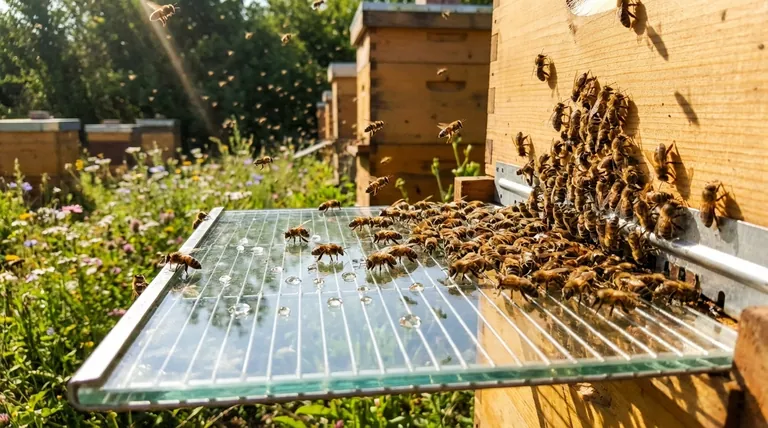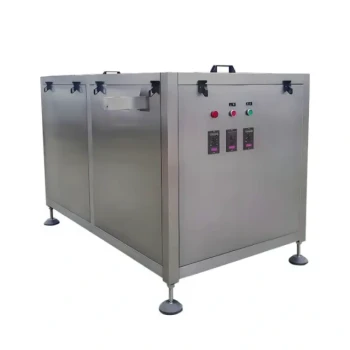Under optimal collection conditions, it takes approximately 10,000 bees to produce one gram of venom. This figure, however, represents the initial liquid venom collected in the field. The actual amount of usable, dry venom produced is significantly smaller, requiring a much larger scale of effort to reach the same one-gram weight.
The core issue is the difference between wet and dry venom. While 10,000 bees can produce one gram of liquid venom, it takes roughly 1 million stings—from as many as 100,000 bees—to yield one gram of the final, potent dry venom used in products.
The Two Measures of Venom Yield
Understanding bee venom production requires differentiating between what is initially collected and the final, processed product. The numbers can seem contradictory without this context.
Liquid Venom: The Initial Collection
Modern venom collection uses a device, typically a glass plate with embedded wires, placed at the hive entrance. A mild electric current stimulates the bees to sting the glass, depositing their venom without losing their stingers and dying.
The 10,000 bees per gram figure refers to the weight of this raw, liquid venom as it is collected on the plate.
Dry Venom: The Final Product
Liquid bee venom is composed mostly of water, which evaporates after collection. What remains is a crystalline, highly concentrated substance known as dry venom. This is the stable and potent form used for medicinal or therapeutic purposes.
According to typical yields, a single bee produces less than 0.1 micrograms of dry venom. This means it takes at least 1 million stings to produce one gram of the final product.
Why the Numbers Differ So Drastically
The discrepancy is simple: water weight. The initial one-gram collection from 10,000 bees is mostly water. Once this water evaporates, you are left with a much smaller quantity of pure, dry venom crystals.
To get one gram of dry venom, you must start with a much larger volume of liquid venom, which in turn requires more bees and more stings. If a bee can be stimulated to sting an average of 10 times, you would need a population of around 100,000 bees to generate the 1 million stings required.
Understanding "Optimum Conditions"
The yield of venom is not static. It depends heavily on a set of ideal circumstances referred to as "optimum conditions."
A Strong and Healthy Colony
The most critical factor is a large, populous, and healthy hive. Stronger colonies are more defensive and have more bees available to interact with the collection device, leading to a higher yield.
Favorable Season and Weather
Bees are most active and productive during warm, sunny weather, typically in late spring and summer. Collection during these periods yields far more venom than during colder or rainier parts of the year when bees are less active.
The Collection Process
"Optimum" also implies correct use of the collection equipment. The electrical impulse must be strong enough to provoke stinging but not so strong as to harm or unduly stress the bees. The collection duration is also timed to maximize yield without exhausting the colony.
The Practical Trade-offs of Venom Collection
While modern methods are non-lethal, venom collection is not a benign process and involves significant challenges.
Stress on the Colony
The collection process is an irritant. It elevates the colony's stress levels and can lead to increased defensiveness and aggression that persists even after the device is removed. Overtaxing a hive can impact its overall health and productivity.
Significant Labor and Scale
As the numbers show, producing a meaningful amount of dry venom is a massive undertaking. It requires managing many strong hives and carefully processing the collected material, which explains the high market value of pure bee venom.
Purity and Contamination
The raw venom scraped from the glass plates must be meticulously handled to prevent contamination from dust, pollen, or other debris. Ensuring the purity of the final product is a critical and challenging step.
Making the Right Choice for Your Goal
Your understanding of these numbers should be guided by your specific interest in bee venom.
- If your primary focus is commercial production: Recognize that producing one gram of pure, dry venom is a large-scale operation requiring a minimum of 100,000 bees and over a million stings.
- If your primary focus is beekeeping hobbyism: Understand that venom collection is a specialized and stressful process for the hive that can negatively impact its temperament and is not a casual undertaking.
- If your primary focus is academic understanding: The key is to always differentiate between the initial wet weight from the field (~10,000 bees/gram) and the final, concentrated dry weight after processing (~100,000+ bees/gram).
Ultimately, the journey from bee to usable venom is a process of intense concentration, requiring a vast number of bees to yield a tiny amount of potent material.

Summary Table:
| Venom Type | Approximate Number of Bees for 1 Gram | Key Characteristic |
|---|---|---|
| Liquid (Wet) Venom | ~10,000 bees | Initial collection; mostly water weight. |
| Dry Venom (Final Product) | ~100,000+ bees | Concentrated, potent form used in products. |
Ready to Scale Your Apiary Operations?
Understanding the immense effort behind bee venom production highlights the need for reliable, high-quality equipment. Whether you're a commercial apiary or a beekeeping equipment distributor, HONESTBEE supplies the durable tools and supplies you need to manage your hives efficiently and humanely.
We help you focus on productivity and bee health with our wholesale-focused operations. Contact HONESTBEE today to discuss your equipment needs and build a stronger, more productive operation.
Visual Guide

Related Products
- Retractable Chinese Queen Rearing Grafting Tools Equipment
- HONESTBEE Bee Frame Grooving Machine | Precision Slotting for Bee Frame Making
- Wooden Queen Bee Excluder for Beekeeping
- No Grafting Queen Rearing Kit: System for Royal Jelly Production and Queen Rearing
- Electric Flatting and Embossing Machine with Tray for Beekeeping
People Also Ask
- What is the Doolittle method of queen rearing? Master Controlled Queen Production for Your Apiary
- Why might grafting be a disincentive for beginners in beekeeping? Explore Simpler Queen Rearing Methods
- What should be done to ensure grafted larvae are well-fed? Master the Principle of Abundance for Queen Rearing
- What characteristics make larvae suitable for grafting? Select the Perfect Larva for Queen Rearing
- What is the purpose of grafting in queen bee production? Scale Your Apiary with Superior Genetics



















